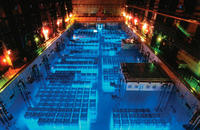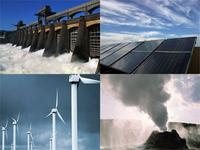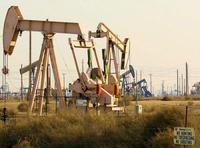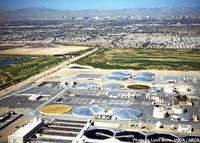-
Loo turns poo into power
Researchers have invented a new toilet system that will turn human waste into electricity and fertilizers and also reduce the amount of water needed for flushing by up to 90 percent compared to current toilet systems
-
-
Recycling nuclear fuel offers plentiful, clean energy

Currently, only about 5 percent of the uranium in a fuel rod gets fissioned for energy in a nuclear reactor; after that, the spent rods, still containing about 95 percent uranium fuel, are taken out of the reactor and put into permanent storage; researchers say that recycling used nuclear fuel could produce hundreds of years of energy from just the uranium that has already been mined, all of it carbon-free
-
-
Larger role for renewable energy in U.S. future than previously thought

Renewable electricity generation from technologies that are commercially available today, in combination with a more flexible electric system, is more than adequate to supply 80 percent of total U.S. electricity generation in 2050 while meeting electricity demand on an hourly basis in every region of the country; new study finds that renewable generation could play a more significant role in the U.S. electricity system than previously thought
-
-
For safer offshore drilling, government should modify monitoring practices

Since the April 2010 Deepwater Horizon blowout and explosion, the federal government as well as the offshore oil and gas industry have been undergoing major changes, including the issuance of regulations requiring operators of offshore facilities to adopt and implement comprehensive Safety and Environmental Management System (SEMS) programs by 15 November 2011
-
-
Knee-strapped power harvester to do away with batteries

Battery-powered devices may soon be a thing of the past; researchers have created an innovative energy harvester to power some of the latest wearable gadgets; the energy harvester, strapped to the knee joint, converts knee motions into energy
-
-
Seabed carpet could harness wave energy
A synthetic “seabed carpet” that mimics the wave-damping effect of a muddy seafloor could be used to extract energy from waves passing over it. As well as offering a new way to produce clean and cheap electricity, the carpet — which has not yet been built — could be used to protect coastal areas against strong waves and provide areas of safe haven for boats in stormy seas
-
-
U.S. energy situation significantly improved

The rhetoric used to discuss the U.S. energy situation does not reflect the new, and much more favorable, energy reality in which the U.S. now finds itself; the last four years have seen a turnaround in U.S. oil production, which has risen 25 percent since 2008 and could increase by 600,000 barrels per day this year; the U.S. net petroleum imports have fallen from 60 percent of total consumption in 2005 to 42 percent today; in 2011 the United States has seen the largest increase in oil production of any country outside of OPEC; significant increases in oil production in Canada and Brazil have significantly bolstered the position of the Western Hemisphere in the global oil production market shift
-
-
Expanding the concept of “urban watershed” to reflect emerging realities

Within two decades, 60 percent of the world’s population will live in cities, and coping with the resulting urban drinking water and sanitation issues will be one of the greatest challenges of this century
-
-
Electrified snail produce electricity from natural sugar in its body
The world’s first “electrified snail” has joined the menagerie of cockroaches, rats, rabbits, and other animals previously implanted with biofuel cells that generate electricity — perhaps for future spy cameras, eavesdropping microphones, and other electronics — from natural sugar in their bodies
-
-
Nuclear, coal-fired electrical plants vulnerable to climate change
Thermoelectric plants, which use nuclear or fossil fuels to heat water into steam that turns a turbine, supply more than 90 percent of U.S. electricity and account for 40 percent of the U.S. freshwater usage; in Europe, these plants supply three-quarters of the electricity and account for about half of the freshwater use; warmer water and reduced river flows in the United States and Europe in recent years have led to reduced production, or temporary shutdown, of several thermoelectric power plants; a new study says this problem will only grow
-
-
Energy-dense biofuel from cellulose may well be economical
Researchers developed a process for creating biofuels which holds the promise of being cost-effective for production scale, opening the door for moving beyond the laboratory setting
-
-
Depleted uranium could reduce world’s dependency on crude oil
Scientists say that a simple 3-step chemical reaction is, in fact, a significant step forward in the search for viable alternatives to crude oil; the discovery means that a simple catalytic process for converting CO directly into more complex and value-added organic molecules may soon be in reach
-
-
Peak oil: is the end of readily available oil supplies in sight?
What happens when a handful of the world’s largest oil fields — accounting for two-thirds of the world’s oil — run dry? What are the implications of such a prospect for food production, economic growth, and ultimately, global security? A new book explains the reality of peak oil and its far-reaching implications for the world’s future
-
-
Spaced-based solar power holds promise
Solar power gathered in space could be set to provide the renewable energy of the future; researchers have already tested equipment in space that would provide a platform for solar panels to collect the energy and allow it to be transferred back to earth through microwaves or lasers
-
-
Grid adjustments cancel out some of wind power’s carbon savings
Wind energy lowers carbon emissions, but adding turbines to the current grid system does not eliminate emissions proportionally, according to a new report; researchers tested how wind energy affects carbon dioxide (CO2) emissions, and found that adjusting for wind power adds inefficiencies that cancel out some of the CO2 reduction
-
- All
- Regional
- Water
- Biometrics
- Borders/Immig
- Business
- Cybersecurity
- Detection
- Disasters
- Government
- Infrastructure
- International
- Public health
- Public Safety
- Communication interoperabillity
- Emergency services
- Emergency medical services
- Fire
- First response
- IEDs
- Law Enforcement
- Law Enforcement Technology
- Military technology
- Nonlethal weapons
- Nuclear weapons
- Personal protection equipment
- Police
- Notification /alert systems
- Situational awareness
- Weapons systems
- Sci-Tech
- Sector Reports
- Surveillance
- Transportation
Advertising & Marketing: advertise@newswirepubs.com
Editorial: editor@newswirepubs.com
General: info@newswirepubs.com
2010-2011 © News Wire Publications, LLC News Wire Publications, LLC
220 Old Country Road | Suite 200 | Mineola | New York | 11501
Permissions and Policies
Editorial: editor@newswirepubs.com
General: info@newswirepubs.com
2010-2011 © News Wire Publications, LLC News Wire Publications, LLC
220 Old Country Road | Suite 200 | Mineola | New York | 11501
Permissions and Policies
